
Radar Men from the Moon is a 1952 Republic Pictures' 12-chapter movie serial, the first Commando Cody serial starring newcomer George Wallace as Cody, Aline Towne as his sidekick Joan Gilbert, and serial veteran Roy Barcroft as the evil Retik, the Ruler of the Moon. The director was Fred C. Brannon, with a screenplay by Ronald Davidson, and special effects by the Lydecker brothers. This serial recycles the flying sequences from Republic's earlier 1949 serial King of the Rocket Men. It was later released by Republic in 1966 as the 100-minute television film Retik the Moon Menace.
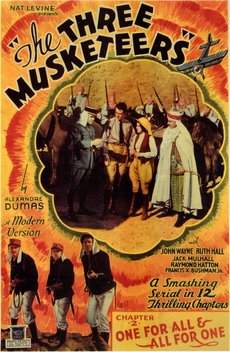
The Three Musketeers is a 1933 American pre-Code film serial directed by Armand Schaeffer and Colbert Clark, and produced by Nat Levine for Mascot Pictures. The film serial was very loosely based on Alexandre Dumas' 1844 novel The Three Musketeers, with the musketeers changed into three soldiers in the French Foreign Legion, and d'Artagnan being reconfigured as Lt. Tom Wayne, a pilot in the United States military.
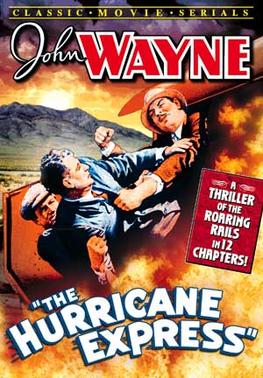
The Hurricane Express is a 1932 American Pre-Code 12-chapter Mascot Pictures film serial. Written by Colbert Clark, Barney Sarecky, Wyndham Gittens, George Morgan, and J.P. McGowan, the serial was directed by Armand Schaeffer and J.P. McGowan and produced by Nat Levine. The Hurricane Express stars John Wayne as aircraft pilot Larry Baker. Wayne goes after a mystery villain named "The Wrecker", who was responsible for a train crash that killed Baker's father.

King of the Texas Rangers (1941) is a Republic film serial. Set in the years prior to America entering World War II, the plot is slightly anachronistic in that the serial features a mix of period western and modern elements, which was not unknown in the B-Western films also produced by Republic. Although the serial's plot involves cowboys battling Axis agents in Texas. Nazis are never named as such but their presence is strongly implied within the serial.
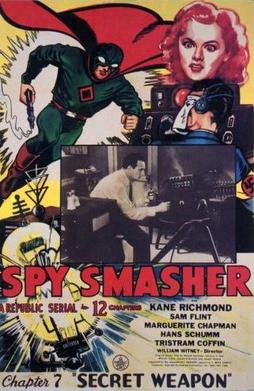
Spy Smasher is a 12-episode 1942 Republic serial film based on the Fawcett Comics character Spy Smasher which is now a part of DC Comics. It was the 25th of the 66 serials produced by Republic. The serial was directed by William Witney with Kane Richmond and Marguerite Chapman as the leads. The serial was Chapman's big break into a career in film and television. Spy Smasher is a very highly regarded serial. In 1966, a television film was made from the serial footage under the title Spy Smasher Returns.

Flying Disc Man from Mars is a 1950 Republic Pictures 12-chapter black-and-white science fiction adventure film serial, produced by Franklin Adreon, directed by Fred C. Brannon, that stars Walter Reed, Lois Collier, Gregory Gaye, James Craven, Harry Lauter, and Richard Irving. Disc Man is considered a weak example of the serial medium, even compared to other post-World War II serials. In 1958 Republic edited the serial's 167 minutes of footage into a 75-minute feature, released under the new title Missile Monsters.
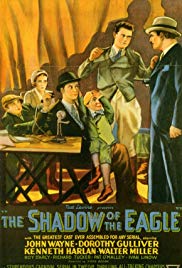
The Shadow of the Eagle is a 1932 American Pre-Code Mascot 12 episode film serial, directed by Ford Beebe and B. Reeves Eason and produced by Nat Levine. The film stars John Wayne in his first serial role. He would go on to star in two other serials for Mascot, The Hurricane Express (1932) and The Three Musketeers (1933). The Shadow of the Eagle is now in the public domain.
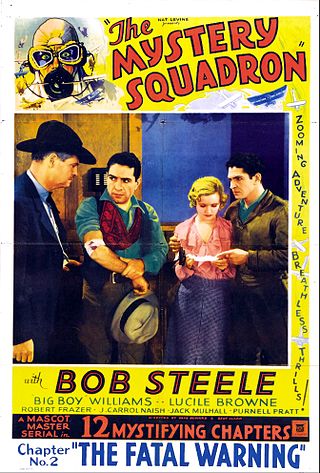
The Mystery Squadron is a 1933 American pre-Code 12-chapter Mascot film serial, directed by Colbert Clark and David Howard. The film was produced by Nat Levine, and stars Western star Bob Steele, Guinn "Big Boy" Williams, Lucile Browne, Purnell Pratt and Jack Mulhall. The Mystery Squadron made an impressive use of a great deal of aerial footage to enliven the action.
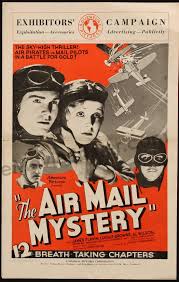
The Airmail Mystery is a 1932 Universal pre-Code movie serial directed by Ray Taylor, written by Ella O'Neill, starring James Flavin and Wheeler Oakman, and featuring Al Wilson doing the aerial stunts. The Airmail Mystery was Universal's first aviation serial that set the pattern for the aviation serials and feature films to follow. The film also marks the film debut of James Flavin. The Airmail Mystery is considered a lost film.

Tailspin Tommy in the Great Air Mystery is a 12-episode 1935 Universal movie serial based on the Tailspin Tommy comic strip by Hal Forrest and starring Clark Williams, Jean Rogers and Noah Beery, Jr. The picture was the 96th of the 137 serials released by the studio.

Junior G-Men of the Air is a 1942 Universal film serial starring the Dead End Kids and the Little Tough Guys. A group of youthful flying enthusiasts join the "Junior G-Men" to help break up a planned attack on the United States.

Junior G-Men is a 1940 Universal film serial. It was Universal's 116th serial of their total of output of 137. The serial is one of the three serials starring "The Dead End Kids and Little Tough Guys" who were under contract to Universal at the time. The plot of Junior G-Men is a pre-World War II G-Man story about fifth columnists in the United States, with the FBI joining forces with youth to save the country.

Sky Raiders is a 12-episode 1941 Universal film serial. The serial was directed by Ford Beebe and Ray Taylor. Sky Raiders stars Donald Woods, Billy Halop, Robert Armstrong and Eduardo Ciannelli. Sky Raiders has little in common with Universal’s other early-1940s espionage outings like Sea Raiders or Junior G-Men, although the serial is often lumped in together as if it is part of a series.

Adventures of the Flying Cadets is a 13-episode 1943 Universal film serial directed by Ray Taylor and Lewis D. Collins.
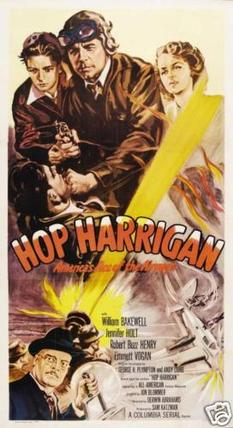
Hop Harrigan (1946) is a Columbia film serial, based on the Hop Harrigan comic books by DC Comics. The serial comprised 15 two-reel chapters with Derwin Abrahams as the director, and Sam Katzman, the producer. Columbia Pictures was one of the last Hollywood studios to continue in postwar years with the serial format. By 1947, Universal Pictures discontinued their serials, with only Republic Pictures and Columbia continuing with serials. The last serial was Columbia's Blazing the Overland Trail (1956).

Eagle of the Night is a 1928 American drama film serial directed by James F. Fulton. Dismissed when released and completely forgotten in the modern era, the 10-chapter aviation serial starred real-life aviator Frank Clarke, a stunt pilot in such fare as Wings (1927), Hell's Angel (1930), and The Flying Deuces (1939).
Hugh Prosser was a Hollywood actor who appeared in over 90 films between 1936 and 1953.
Doctor Satan's Robot is a 1966 made for television film condensed from the original 1940 Mysterious Doctor Satan film serial named after its chief villain. Master criminal Doctor Satan has a nemesis, a masked mystery man, the "Copperhead", whose secret identity is Bob Wayne. Wearing a copper mask, Wayne is searching for justice and revenge on Satan for the death of his step-father. With Doctor Satan creating a mechanical robot that will terrorize the world, Wayne is determined to stop the criminal plans of the evil doctor.

Frank Clarke was a Hollywood stunt pilot, actor, and military officer. His most prominent role was as Leutnant von Bruen in the 1930 production Hell's Angels, but he flew for the camera and performed stunts in more than a dozen films in the 1930s and 1940s. Clarke was killed in an aircraft crash near Isabella, California, in 1948.

Blackhawk is a 1952 American 15-chapter science fiction adventure movie serial from Columbia Pictures, based on the comic book Blackhawk, first published by Quality Comics, but later owned by competitor DC Comics. It was Columbia's forty-ninth serial. The one-sheet poster referred to the serial as The Miraculous Blackhawk: Freedom's Champion. The home video release added the tagline: "Fearless Champion of Freedom".


















